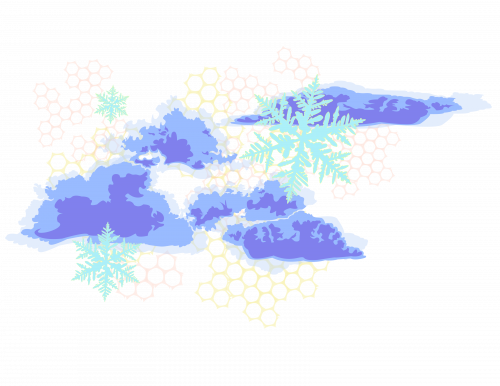Understanding Cloud Behavior through Computational Modeling
On some days during the coldest months of winter, we are greeted by fluffy snow falling from the sky when we venture outside. On other days, it’s rain or an unpleasant combination of freezing sleet and snow. What comes from the clouds on a given day might seem random, but scientists are coming up with new ways to predict these seemingly mysterious weather patterns.
Amir Haji-Akbari, assistant professor of Chemical and Environmental Engineering at Yale, uses computational simulations to study how ice and snow form from microdroplets of water in clouds. Clouds are large, visible masses of condensed water vapor floating high up in the atmosphere; studying the behavior of the water molecules that make up these clouds can therefore help scientists understand different weather patterns. Haji-Akbari employs computer models to predict how the water droplets in clouds form into frozen particles in a process called nucleation, providing some insight into weather patterns.
“Ice formation is a very important component of what happens in clouds. It’s a very important part of cloud microphysics, and the amount of ice you have in a cloud determines how likely it is to produce rain and snow,” Haji-Akbari said.
Clouds contain water droplets that are light enough to float in the air without falling. These water droplets come from evaporating water from the Earth’s surface that condenses or freezes as it gets higher up in the atmosphere, often times around a nucleus such as a dust particle or an aerosol. Eventually, that water comes back to the Earth’s surface in the form of rain or snow. However, it is unclear how and when water droplets and ice crystals form, and scientists like Haji-Akbari are trying to develop new ways of understanding the physics behind these processes.
In a recent study published in PNAS, Haji-Akbari investigated how the vapor-liquid interface affects the freezing of water molecules. He simulated the formation of two different types of ice crystal structures called the hexagonal cage structure and the double diamond cage structure. The hexagonal cage structures tend to be found in the kind of ice we see in everyday life, because their chemical structures make them more stable. Double-diamond cage structures, on the other hand, are typically found in cubic ice and only form at extremely low temperatures. By studying the behavior of these ice structures, Haji-Akbari analyzed how likely they were to form under various conditions. Specifically, he observed that the vapor-liquid interface in thin films of water promotes the formation of double-diamond cages. Haji-Akbari’s findings answer longstanding questions about ice formation near surfaces.
In order to carry out his study, Haji-Akbari used computational techniques to simulate molecular behavior, which involves generating models to predict events on a microscopic scale in a way that wouldn’t be possible through traditional physical experimentation. One technique used was forward flux sampling, which maps out the pathway that a system takes during the occurrence of a rare event, such as ice and snow formation.
“These are phenomena that occur very quickly, but you have to wait a very long time for them to occur,” Haji-Akbari said. “You can think of, for example, a power outage. You have to wait a long time for it to happen, but when it happens it happens in a matter of seconds.” Haji-Akbari studies how a system transitions from the pre-rare event to the post-rare event state, such as when ice forms in clouds.
Haji-Akbari is now pursuing several other research questions that build on his past findings. He is interested in a phenomenon called contact freezing, in which a collision between a liquid droplet and a dry nucleating particle causes freezing. The question is whether the mechanical impact of the collision causes freezing, or whether this is due to an interaction between the solid-liquid and liquid-vapor interface. Additionally, Haji-Akbari is studying how new computational methods could better predict the waiting time required for rare events such as ice formation to occur.
This research has many applications not only in understanding and predicting climate patterns but also in potentially developing strategies to address climate-related issues. For instance, cloud seeding is a technique already used in many parts of the world to induce rain. In cloud seeding, crystals such as salts are dispersed into clouds in order to provide additional nuclei for droplet condensation. Haji-Akbari’s research focuses on a related process, liquid droplets nucleating to form ice crystals. He hopes that research such as his will improve on the efficiency and safety of techniques to modify the weather, for instance to induce or prevent snow and ice formation.
Haji-Akbari pointed out climate patterns around the world that have recently been disrupted by climate change, noting examples of drought in several countries. To him, asking and trying to address scientific questions about atmospheric dynamics can lead to a better understanding of our environment and even the ability to change the climate. “These are problems that are not only theoretically interesting, but also useful for the challenges that our society and our species face in the world,” Haji-Akbari said.
About the Author
Christine Xu is a senior in Saybrook College. She has been writing for Yale Scientific Magazine since her freshman year and was the previous News Editor. She enjoys both nonfiction and creative writing, and also does neurobiology research at the Yale School of Medicine. In the future, she hopes to pursue a career in medicine, research, and writing, and importantly would like to own a cat.
Acknowledgements
The author would like to thank Dr. Haji Akbari for his time and enthusiasm in sharing his work.

